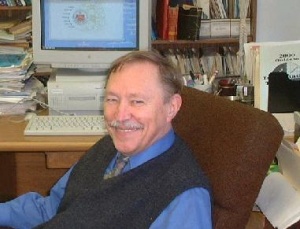Difference between revisions of "Ryszard Michalski"
GerdIsenberg (talk | contribs) |
GerdIsenberg (talk | contribs) |
||
| (2 intermediate revisions by the same user not shown) | |||
| Line 4: | Line 4: | ||
'''Ryszard S. Michalski''' (May 7, 1937 - September 20, 2007),<br/> | '''Ryszard S. Michalski''' (May 7, 1937 - September 20, 2007),<br/> | ||
| − | a Polish American computer scientist and pioneer in [[Learning|machine learning]]. While working at the [https://en.wikipedia.org/wiki/Polish_Academy_of_Sciences Polish Academy of Sciences] in the 60s, Michalski devised an early computer system that could [https://en.wikipedia.org/wiki/Handwriting_recognition recognize handwriting]. After coming to the United States in 1970, working and teaching at [[University of Illinois at Urbana-Champaign]] and from 1988 at [https://en.wikipedia.org/wiki/George_Mason_University George Mason University], where he founded the Machine Learning Laboratory <ref>[http://www.mli.gmu.edu/ Machine Learning and Inference Laboratory at George Mason University]</ref>, he created applications in which computers could execute a form of reasoning, drawing conclusions from information supplied to them. In 1997, he developed an influential computational system he called the [https://en.wikipedia.org/wiki/Learnable_Evolution_Model Learnable Evolution Model]. Ryszard Michalski died on September 20, 2007 of cancer, aged 70. | + | was a Polish American computer scientist and pioneer in [[Learning|machine learning]]. While working at the [https://en.wikipedia.org/wiki/Polish_Academy_of_Sciences Polish Academy of Sciences] in the 60s, Michalski devised an early computer system that could [https://en.wikipedia.org/wiki/Handwriting_recognition recognize handwriting]. After coming to the United States in 1970, working and teaching at [[University of Illinois at Urbana-Champaign]] and from 1988 at [https://en.wikipedia.org/wiki/George_Mason_University George Mason University], where he founded the Machine Learning Laboratory <ref>[http://www.mli.gmu.edu/ Machine Learning and Inference Laboratory at George Mason University]</ref>, he created applications in which computers could execute a form of reasoning, drawing conclusions from information supplied to them. In 1997, he developed an influential computational system he called the [https://en.wikipedia.org/wiki/Learnable_Evolution_Model Learnable Evolution Model]. Ryszard Michalski died on September 20, 2007 of cancer, aged 70. |
=Selected Publications= | =Selected Publications= | ||
| − | <ref>[ | + | <ref>[[ICGA Journal#RefDB|ICGA Reference Database]]</ref> <ref>[https://dblp.uni-trier.de/pers/hd/m/Michalski:Ryszard_S=.html dblp: Ryszard S. Michalski]</ref> |
==1970 ...== | ==1970 ...== | ||
* [[Ryszard Michalski]], [https://en.wikipedia.org/wiki/Zenon_Kulpa Zenon Kulpa] ('''1971'''). ''[https://www.semanticscholar.org/paper/A-System-of-Programs-for-the-Synthesis-of-Switching-Michalski-Kulpa/95882e3c4df9478121c8b230dfcc21042c8bae9f A System of Programs for the Synthesis of Switching Circuits Using the Method of Disjoint Stars]''. [[Conferences#IFIP5|IFIP Congress]] | * [[Ryszard Michalski]], [https://en.wikipedia.org/wiki/Zenon_Kulpa Zenon Kulpa] ('''1971'''). ''[https://www.semanticscholar.org/paper/A-System-of-Programs-for-the-Synthesis-of-Switching-Michalski-Kulpa/95882e3c4df9478121c8b230dfcc21042c8bae9f A System of Programs for the Synthesis of Switching Circuits Using the Method of Disjoint Stars]''. [[Conferences#IFIP5|IFIP Congress]] | ||
* [[Ryszard Michalski]], [[Pericles Negri]] ('''1977'''). ''An experiment on inductive learning in chess endgames''. [https://www.doc.ic.ac.uk/~shm/MI/mi8.html Machine Intelligence 8], [http://www.mli.gmu.edu/papers/69-78/77-1.pdf pdf] | * [[Ryszard Michalski]], [[Pericles Negri]] ('''1977'''). ''An experiment on inductive learning in chess endgames''. [https://www.doc.ic.ac.uk/~shm/MI/mi8.html Machine Intelligence 8], [http://www.mli.gmu.edu/papers/69-78/77-1.pdf pdf] | ||
| − | * [[Ryszard Michalski]] ('''1977'''). ''[http://mars.gmu.edu/handle/1920/1541?show=full A System of Programs for Computer-Aided Induction: A Summary]''. [[Conferences | + | * [[Ryszard Michalski]] ('''1977'''). ''[http://mars.gmu.edu/handle/1920/1541?show=full A System of Programs for Computer-Aided Induction: A Summary]''. [[Conferences#IJCAI1977|IJCAI 1977]] |
==1980 ...== | ==1980 ...== | ||
* [[Ryszard Michalski]], [[Jaime Carbonell]], [[Tom Mitchell]] ('''1983'''). ''[https://link.springer.com/book/10.1007%2F978-3-662-12405-5 Machine Learning: An Artificial Intelligence Approach]''. [https://en.wikipedia.org/wiki/Springer_Science%2BBusiness_Media Springer] | * [[Ryszard Michalski]], [[Jaime Carbonell]], [[Tom Mitchell]] ('''1983'''). ''[https://link.springer.com/book/10.1007%2F978-3-662-12405-5 Machine Learning: An Artificial Intelligence Approach]''. [https://en.wikipedia.org/wiki/Springer_Science%2BBusiness_Media Springer] | ||
Latest revision as of 17:51, 16 November 2020
Home * People * Ryszard Michalski

Ryszard S. Michalski (May 7, 1937 - September 20, 2007),
was a Polish American computer scientist and pioneer in machine learning. While working at the Polish Academy of Sciences in the 60s, Michalski devised an early computer system that could recognize handwriting. After coming to the United States in 1970, working and teaching at University of Illinois at Urbana-Champaign and from 1988 at George Mason University, where he founded the Machine Learning Laboratory [2], he created applications in which computers could execute a form of reasoning, drawing conclusions from information supplied to them. In 1997, he developed an influential computational system he called the Learnable Evolution Model. Ryszard Michalski died on September 20, 2007 of cancer, aged 70.
Contents
Selected Publications
1970 ...
- Ryszard Michalski, Zenon Kulpa (1971). A System of Programs for the Synthesis of Switching Circuits Using the Method of Disjoint Stars. IFIP Congress
- Ryszard Michalski, Pericles Negri (1977). An experiment on inductive learning in chess endgames. Machine Intelligence 8, pdf
- Ryszard Michalski (1977). A System of Programs for Computer-Aided Induction: A Summary. IJCAI 1977
1980 ...
- Ryszard Michalski, Jaime Carbonell, Tom Mitchell (1983). Machine Learning: An Artificial Intelligence Approach. Springer
- Ryszard Michalski, Jaime Carbonell, Tom Mitchell (1985, 2014). Learning: An Artificial Intelligence Approach, Volume I. Morgan Kaufmann
- Ryszard Michalski, Jaime Carbonell, Tom Mitchell (1986). Machine Learning: An Artificial Intelligence Approach, Volume II. Morgan Kaufmann
- Tom Mitchell, Jaime Carbonell, Ryszard Michalski (1986). Machine Learning: A Guide to Current Research. The Kluwer International Series in Engineering and Computer Science, Vol. 12
- Ryszard Michalski, Patrick Winston (1986). Variable Precision Logic. Artificial Intelligence, Vol. 29, pdf
1990 ...
- Yves Kodratoff, Ryszard Michalski (1990, 2014). Machine Learning : An Artificial Intelligence Approach, Volume III. Morgan Kaufmann
- Ryszard Michalski, George Tecuci (1994). Machine Learning: A Multistrategy Approach, Volume IV. Morgan Kaufmann
- Ryszard Michalski (1998). Learnable Evolution: Combining Symbolic and Evolutionary Learning. Proceedings of the Fourth International Workshop on Multistrategy Learning
- Ryszard Michalski, Ivan Bratko, Miroslav Kubat (eds.) (1998). Machine Learning and Data Mining: Methods and Applications. John Wiley & Sons
- Miroslav Kubat, Ivan Bratko, Ryszard Michalski (1998). A Review of Machine Learning Methods. pdf
2000 ...
- Ryszard Michalski (2000). Inductive Databases and Knowledge Scouts. PAKDD 2000
- Ryszard Michalski (2000). Learning and Evolution: An Introduction to Non-darwinian Evolutionary Computation. ISMIS 2000
- Ryszard Michalski (2000). LEARNABLE EVOLUTION MODEL Evolutionary Processes Guided by Machine Learning. Machine Learning, Vol. 38, Nos. 1-2